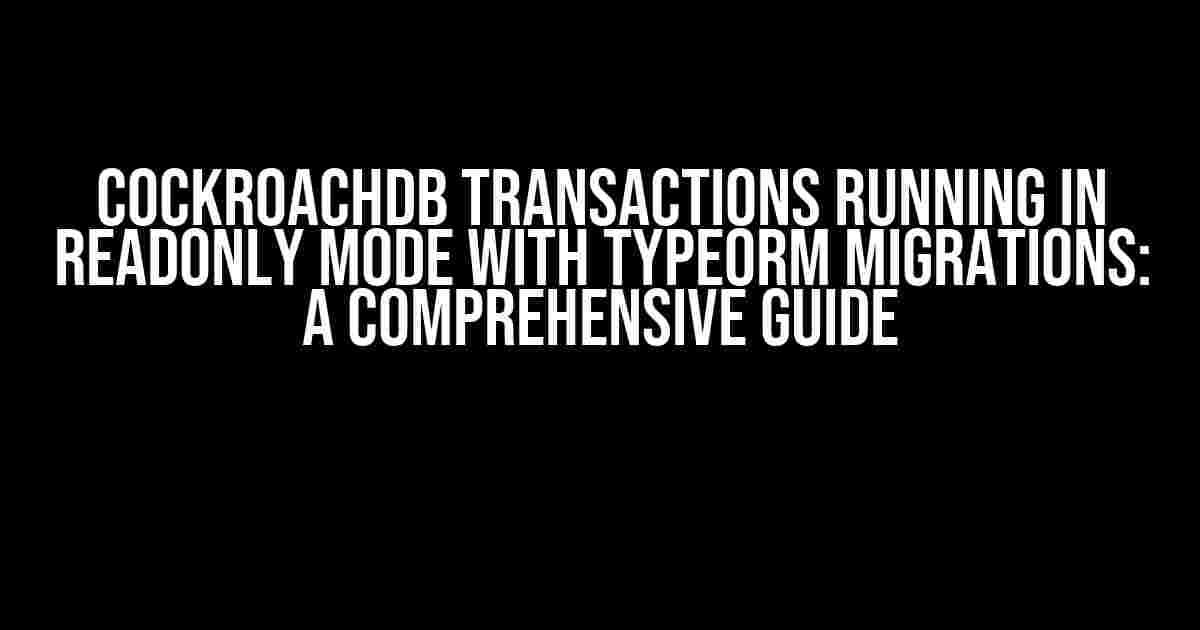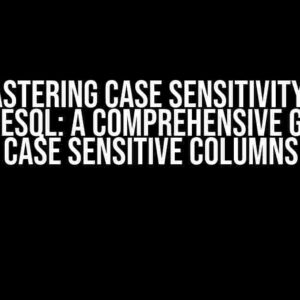Are you tired of dealing with transactional errors in your CockroachDB database? Do you want to ensure data consistency and integrity while running migrations with TypeORM? Look no further! In this article, we’ll delve into the world of CockroachDB transactions running in readonly mode with TypeORM migrations, providing you with clear instructions and explanations to get you started.
What is CockroachDB?
CockroachDB is a cloud-native, open-source relational database management system (RDBMS) that’s designed to be highly scalable, resilient, and secure. It’s built on top of the RocksDB storage engine and uses the PostgreSQL wire protocol, making it compatible with most PostgreSQL tools and drivers.
What are TypeORM Migrations?
TypeORM is a TypeScript ORM (Object-Relational Mapping) tool that enables you to interact with your database using a simple, intuitive API. TypeORM migrations are a way to manage changes to your database schema over time, allowing you to version control your database and ensure that changes are applied consistently across different environments.
The Problem: Transactions in Readonly Mode
When running TypeORM migrations against a CockroachDB database, you may encounter issues with transactions running in readonly mode. This occurs because CockroachDB is designed to be highly available and resilient, and readonly mode is used to ensure data consistency during transactions.
Symptoms of the Problem
- Transactions fail with errors indicating that the database is in readonly mode
- Migrations stall or timeout due to readonly mode
- Data inconsistencies or corruption occur due to incomplete transactions
Solution: Configuring CockroachDB for Readonly Mode Transactions
To overcome the challenges of running transactions in readonly mode, you’ll need to configure your CockroachDB database to allow for writes during migrations. Here’s how:
Step 1: Create a New CockroachDB Cluster
First, create a new CockroachDB cluster using the Cockroach Labs-provided cloud console or by running the following command:
cockroach start --insecure --listen-addr 0.0.0.0:26257 --http-addr 0.0.0.0:8080Step 2: Enable Writes During Migrations
To enable writes during migrations, you’ll need to set the `default_transaction_read_only` cluster setting to `false`. You can do this using the CockroachDB SQL shell:
sql> SET CLUSTER SETTING default_transaction_read_only = false;Step 3: Create a TypeORM Configuration File
Create a new file called `typeorm.config.ts` with the following contents:
import { ConnectionOptions } from 'typeorm';
import { CockroachDBDriver } from 'typeorm-database-json';
const config: ConnectionOptions = {
type: 'cockroachdb',
url: 'postgresql://root@localhost:26257/defaultdb',
username: 'root',
password: '',
database: 'defaultdb',
entities: [__dirname + '/../**/*.entity{.ts,.js}'],
migrations: [__dirname + '/../migrations/*{.ts,.js}'],
cli: {
migrationsDir: 'migrations',
},
driver: CockroachDBDriver,
};
export = config;Running TypeORM Migrations with CockroachDB
With your CockroachDB cluster configured and your TypeORM configuration file in place, you’re ready to run your migrations:
Step 1: Create a New Migration
Use the TypeORM CLI to create a new migration:
npx typeorm migration:create -n CreateUsersTableStep 2: Write Your Migration Code
Edit the generated migration file (`migrations/ timestamp-create-users-table.ts`) and add the following code:
import { MigrationInterface, QueryRunner } from 'typeorm';
export class CreateUsersTable1643723403000 implements MigrationInterface {
public async up(queryRunner: QueryRunner): Promise {
await queryRunner.query(`
CREATE TABLE users (
id SERIAL PRIMARY KEY,
name VARCHAR(255) NOT NULL,
email VARCHAR(255) NOT NULL UNIQUE
);
`);
}
public async down(queryRunner: QueryRunner): Promise {
await queryRunner.query(`
DROP TABLE users;
`);
}
} Step 3: Run the Migration
Use the TypeORM CLI to run the migration:
npx typeorm migration:runBest Practices for CockroachDB Transactions
To ensure data consistency and integrity, follow these best practices when running transactions in readonly mode with TypeORM migrations:
- Use explicit transactions: When running migrations, use explicit transactions to ensure that changes are atomic and consistent.
- Set the transaction isolation level: Set the transaction isolation level to `serializable` or `repeatable read` to ensure consistency and prevent concurrent modifications.
- Use retries and timeouts: Implement retries and timeouts to handle transient errors and ensure that migrations complete successfully.
- Monitor and log transactions: Monitor and log transactions to detect and troubleshoot any issues that may arise.
- Test thoroughly: Test your migrations thoroughly to ensure that they complete successfully and consistently.
Conclusion
In this article, we’ve explored the challenges of running transactions in readonly mode with TypeORM migrations on CockroachDB. By configuring your CockroachDB cluster to allow writes during migrations and following best practices for transactions, you can ensure data consistency and integrity while running migrations.
| Topic | Description |
|---|---|
| CockroachDB | A cloud-native, open-source relational database management system |
| TypeORM Migrations | A way to manage changes to your database schema over time |
| Readonly Mode | A mode that prevents writes to the database during transactions |
| Configuring CockroachDB for Readonly Mode Transactions | Steps to enable writes during migrations |
| Running TypeORM Migrations with CockroachDB | Steps to create and run migrations with TypeORM and CockroachDB |
| Best Practices for CockroachDB Transactions | Guidelines for ensuring data consistency and integrity |
By following the instructions and best practices outlined in this article, you’ll be well on your way to running successful transactions in readonly mode with TypeORM migrations on CockroachDB.
Frequently Asked Questions
Get the scoop on CockroachDB transactions running in readonly mode with TypeORM migrations!
Q1: Why do my CockroachDB transactions fail when running in readonly mode with TypeORM migrations?
When you run your CockroachDB transactions in readonly mode, the database is essentially locked down, preventing any modifications. TypeORM migrations, however, attempt to execute DDL (Data Definition Language) statements to alter your database schema. These statements require write access, which is denied in readonly mode, causing your transactions to fail.
Q2: How can I temporarily allow writes in CockroachDB during TypeORM migrations?
You can use the `SET TRANSACTION READ WRITE` statement in your CockroachDB configuration to temporarily enable write access during TypeORM migrations. This allows your migrations to execute successfully, and then you can revert back to readonly mode once the migration is complete.
Q3: Will CockroachDB’s readonly mode affect the performance of my TypeORM application?
CockroachDB’s readonly mode can impact the performance of your TypeORM application, especially if you’re performing complex queries or transactions. Since readonly mode disallows writes, any queries that attempt to modify data will fail, which can lead to errors and slower performance. However, if your application is primarily read-heavy, readonly mode can actually improve performance by reducing contention and improving concurrency.
Q4: Can I use CockroachDB’s readonly mode with other ORMs besides TypeORM?
Yes, CockroachDB’s readonly mode is not specific to TypeORM and can be used with other ORMs (Object-Relational Mappers) like Sequelize, Prisma, or even raw SQL queries. The readonly mode is a feature of CockroachDB itself, and any client that connects to the database can take advantage of it.
Q5: Are there any alternative solutions to CockroachDB’s readonly mode for TypeORM migrations?
Yes, if you’re finding CockroachDB’s readonly mode too restrictive, you can consider alternative solutions like using a separate “migration” database or schema that allows writes, or implementing a queue-based system to handle migrations asynchronously. Another option is to use a different database system that supports online schema changes, such as PostgreSQL.


